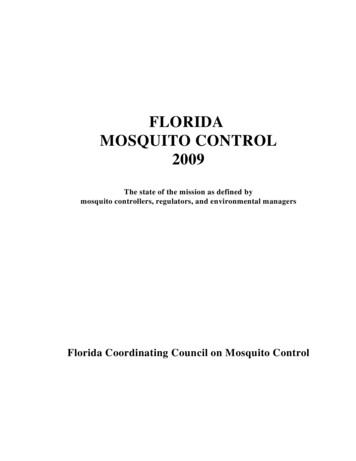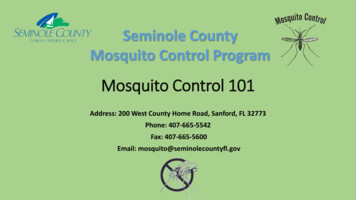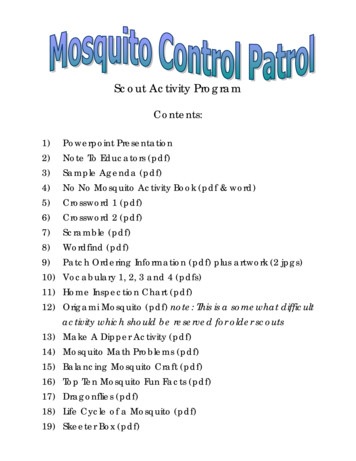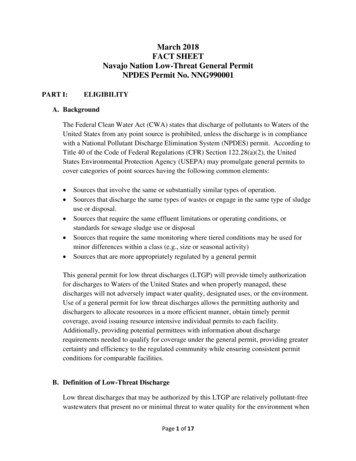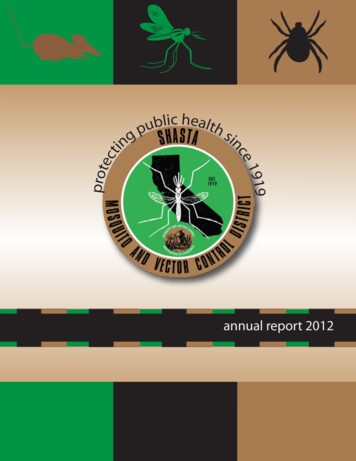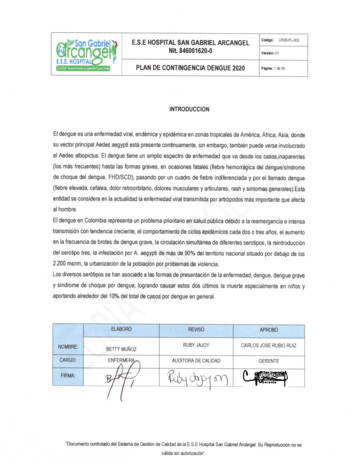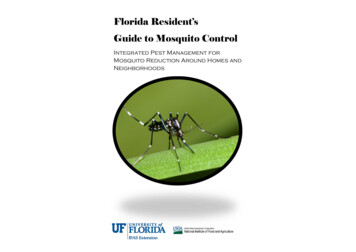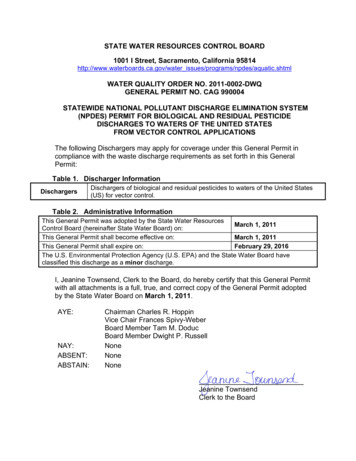
Transcription
STATE WATER RESOURCES CONTROL BOARD1001 I Street, Sacramento, California 95814http://www.waterboards.ca.gov/water issues/programs/npdes/aquatic.shtmlWATER QUALITY ORDER NO. 2011-0002-DWQGENERAL PERMIT NO. CAG 990004STATEWIDE NATIONAL POLLUTANT DISCHARGE ELIMINATION SYSTEM(NPDES) PERMIT FOR BIOLOGICAL AND RESIDUAL PESTICIDEDISCHARGES TO WATERS OF THE UNITED STATESFROM VECTOR CONTROL APPLICATIONSThe following Dischargers may apply for coverage under this General Permit incompliance with the waste discharge requirements as set forth in this GeneralPermit:Table 1. Discharger InformationDischargersDischargers of biological and residual pesticides to waters of the United States(US) for vector control.Table 2. Administrative InformationThis General Permit was adopted by the State Water ResourcesMarch 1, 2011Control Board (hereinafter State Water Board) on:This General Permit shall become effective on:March 1, 2011This General Permit shall expire on:February 29, 2016The U.S. Environmental Protection Agency (U.S. EPA) and the State Water Board haveclassified this discharge as a minor discharge.I, Jeanine Townsend, Clerk to the Board, do hereby certify that this General Permitwith all attachments is a full, true, and correct copy of the General Permit adoptedby the State Water Board on March 1, 2011.AYE:NAY:ABSENT:ABSTAIN:Chairman Charles R. HoppinVice Chair Frances Spivy-WeberBoard Member Tam M. DoducBoard Member Dwight P. RussellNoneNoneNoneJeanine TownsendClerk to the Board
GENERAL NPDES PERMIT FOR BIOLOGICAL AND RESIDUALPESTICIDE DISCHARGES FROM VECTOR CONTROL APPLICATIONSORDER NO. 2011-0002-DWQNPDES NO. CAG 990004Table of ContentsI.II.Discharge Information . 4Permit Coverage and Application Requirements. 4A. General Permit Coverage . 4B. Discharger . 5C. General Permit Application . 5D. Fees. 6E. Terminating Coverage . 6III. Findings. 6A. Background. 6B. Legal Authorities . 7C. Background and Rationale for Requirements . 7D. California Environmental Quality Act (CEQA) . 8E. Related Pesticide Regulations . 81. U.S. EPA. 82. DPR . 83. County Agricultural Commissioners . 94. CDPH. 9F. Technology-Based Effluent Limitations. 9G. Water Quality-Based Effluent Limitations. 9H. Receiving Water Monitoring Triggers. 10I. Beneficial Uses in Basin Plans . 10J. National Toxics Rule (NTR) and California Toxics Rule (CTR). 11K. State Implementation Policy (SIP) . 11L. Antidegradation Policy . 11M. Endangered Species Act . 12N. Monitoring and Reporting. 13O. Standard and Special Provisions . 13P. Notification of Interested Parties . 13Q. Consideration of Public Comment . 13IV. Discharge Prohibitions. 13V. Effluent Limitations . 14VI. Receiving Water Limitations . 14VII. Receiving Water Monitoring Triggers . 15VIII. Pesticide Use Requirements . 15IX. Provisions. 19A. Standard Provisions. 19B. Monitoring and Reporting Program (MRP) Requirements . 21C. Special Provisions . 21Table 1.Table 2.Table 3.Table 4.List of TablesDischarger Information. 1Administrative Information. 1Receiving Water Limitation. 14Receiving Water Monitoring Triggers . 152
GENERAL NPDES PERMIT FOR BIOLOGICAL AND RESIDUALPESTICIDE DISCHARGES FROM VECTOR CONTROL APPLICATIONSORDER NO. 2011-0002-DWQNPDES NO. CAG 990004List of AttachmentsAttachment A – Definitions .A-1Attachment B – Standard Provisions .B-1Attachment C – Monitoring and Reporting Program .C-1Attachment D – Fact Sheet.D-1Attachment E – List of permitted Adulticide Products .E-1Attachment F – List of permitted Larvicide Products . F-1Attachment G – Notice of Intent. G-1Attachment H – Notice of Termination .H-13
GENERAL NPDES PERMIT FOR BIOLOGICAL AND RESIDUALPESTICIDE DISCHARGES FROM VECTOR CONTROL APPLICATIONSI.ORDER NO. 2011-0002-DWQNPDES NO. CAG 990004DISCHARGE INFORMATIONPesticide formulations may include “active ingredients” 1 and “inert ingredients” 2.Adjuvants 3 or surfactants may be added to the ingredients in the application equipmentthat is used in the delivery of the pesticide. As part of the registration process ofpesticides for use in California, U.S. EPA and the California Department of PesticideRegulation (DPR) evaluate data submitted by registrants to ensure that a product usedaccording to label instructions will cause no harm or adverse impact on non-targetorganisms that cannot be reduced or mitigated with protective measures or userestrictions. The Clean Water Act (CWA), at section 301(a), broadly prohibits thedischarge of any pollutant to waters of the US*, except in compliance with an NPDESpermit. Biological and residual pesticides* discharged into surface waters constitutepollutants within the meaning of the CWA even if the discharge is in compliance with theregistration requirements of the Federal Insecticide, Fungicide, and Rodenticide Act(FIFRA). Therefore, coverage under an NPDES permit is required.The discharge of biological and residual pesticides to waters of the US from larvicide* andadulticide* 4 applications for vector control 5 throughout the State of California may pose athreat to existing and potential beneficial uses of waters of the US if not properly controlledand regulated. Therefore, this General Permit incorporates discharge prohibitionscontained in water quality control plans (Basin Plans), as implemented by the State WaterBoard and the nine Regional Water Quality Control Boards (Regional Water Boards).II.PERMIT COVERAGE AND APPLICATION REQUIREMENTSA. General Permit CoverageThis General Permit covers the point source discharge of biological and residualpesticides resulting from direct and spray applications for vector control using:1) larvicides containing monomolecular films, methoprene, Bacillus thuringiensissubspecies isralensis (or Bti), Bacillus sphaericus (or B. Sphaericus), temephos,petroleum distillates, or spinosad; and 2) adulticides containing malathion, naled,pyrethrin, permethrin, resmethrin, sumithrin, prallethrin, piperonyl butoxide (PBO),etofenprox, or N-octyl bicycloheptene dicarboximide (or MGK-264). Users of productscontaining these active ingredients are required to obtain coverage under this GeneralPermit prior to application to waters of the US. This General Permit only covers thedischarge of larvicides and adulticides that are currently registered in California.1Active ingredients are manufacturer disclosed ingredients that yield toxic effects on target organisms.Inert ingredients are additional ingredients and are often trade secrets; therefore, they are not always disclosedby the manufacturer.3Adjuvants are ingredients that are added to pesticides during an application event and are often trade secrets.These ingredients are chosen by the Discharger, based on site characteristics, and typically increase theeffectiveness of pesticides on target organisms.*Defined in Attachment A – Definitions.4This General Permit does not cover biological pesticides for adulticide applications.5Vector is defined in this General Permit as mosquitoes, black flies, and midges.2LIMITATIONS AND DISCHARGE REQUIREMENTS4
GENERAL NPDES PERMIT FOR BIOLOGICAL AND RESIDUALPESTICIDE DISCHARGES FROM VECTOR CONTROL APPLICATIONSORDER NO. 2011-0002-DWQNPDES NO. CAG 990004Attachments E and F 6 list the currently registered products containing these activeingredients.B. DischargerA Discharger under this General Permit includes any entity involved in the applicationof vector control pesticides that results in a discharge of biological and residualpesticides to waters of the US, and meets either or both of the following two criteria:1. The entity has control over the financing for or the decision to perform pesticideapplications that result in discharges including the ability to modify those decisions;or2. The entity has day-to-day control of pesticide application or performs activities thatare necessary to ensure compliance with this General Permit. For example, theentity is authorized to direct workers to carry out activities required by this GeneralPermit or perform such activities themselves.C. General Permit ApplicationTo obtain authorization under this General Permit, Dischargers must submit acomplete application to the State Water Board as described below:1. A Notice of Intent (NOI shown as Attachment G) signed in accordance with thesignatory requirements of the Standard Provisions in Attachment B;2. An application fee; and3. A Pesticide Application Plan (PAP).State and Regional Water Board staff will review the application package forcompleteness and applicability under this General Permit. Additionally, the StateWater Board’s Deputy Director of the Division of Water Quality (Deputy Director) mayissue a Notice of Exclusion (NOE) 7, which either terminates coverage under thisGeneral Permit or requires submittal of an application for an individual permit oralternative general permit.Permit coverage will be effective when all of the following have occurred:1. The Discharger has submitted a complete permit application;2. The PAP has been posted on the State Water Board’s website for a 30-day forcomment period 8 and approved by the Deputy Director; and6The California Department of Public Health (formerly Department of Health Services) has provided the StateWater Board with the lists of mosquito adulticides and larvicides most commonly used in California.7An NOE is a one-page notice that indicates and justifies why the Discharger or proposed Discharger is noteligible for coverage under this General Permit. This justification can include, but is not limited to, the necessityto comply with a total maximum daily load (TMDL) or to protect sensitive water bodies. The NOE can alsoindicate that the coverage is denied if feasible alternatives to the selected pesticide application project are notanalyzed.8See Waterkeeper Alliance, Inc. v. EPA, 399 F.3d 486 (2nd Cir. 2005).LIMITATIONS AND DISCHARGE REQUIREMENTS5
GENERAL NPDES PERMIT FOR BIOLOGICAL AND RESIDUALPESTICIDE DISCHARGES FROM VECTOR CONTROL APPLICATIONSORDER NO. 2011-0002-DWQNPDES NO. CAG 9900043. The Deputy Director has issued a Notice of Applicability (NOA). The NOA willspecify the pesticide products or type(s) of pesticides that may be used and anyRegional Water Board specific conditions and requirements not stated in thisGeneral Permit. Any such Region-specific conditions and requirements shall beenforceable. The Discharger is authorized to discharge starting on the date of theNOA.D. FeesThe fee for enrollment under this General Permit shall be based on Section 2200(b)(6)of Title 23, California Code of Regulations (CCR), which is available s/fy10 11 fee schedule.pdf and ispayable to the State Water Board.E. Terminating CoverageTo terminate permit coverage, a Discharger must submit a complete and accurateNotice of Termination (NOT) provided in Attachment H. The Discharger’sauthorization to discharge under this General Permit terminates on the date of thecoverage termination letter issued by the State Water Board. Prior to the terminationeffective date, the Discharger is subject to the terms and conditions of this GeneralPermit and is responsible for submitting the annual fee and all reports associated withthis General Permit.A Discharger must submit an NOT when one of the following conditions occurs:1. The Discharger has ceased all discharges from the application of pesticides forwhich it obtained General Permit coverage and does not expect to dischargeduring the remainder of the permit term; or2. The Discharger has obtained coverage under an individual permit or an alternativegeneral permit for all discharges required to be covered by an NPDES permit.III. FINDINGSThe State Water Board finds:A. Background1. An NPDES Permit is required for applications of pesticides that result in adischarge of pollutants to waters of the US. Courts have determined that pesticidesmay constitute chemical wastes or biological materials within the meaning of theCWA. 9 Under current case law, whether a permit is required depends uponwhether it is a biological or chemical pesticide and, for chemical pesticides,whether there is any residue or unintended effect from its application.2. U.S. EPA’s 2006 regulation attempting to exempt certain FIFRA-compliantapplications of pesticides was invalidated and vacated by the Sixth Circuit Court of9Headwaters, Inc. v. Talent Irrigation District, (9th Cir. 2001) 243 F.3d 526; League of Wilderness Defenders v.Forsgren (9th Cir. 2002) 309 F.3d 526; Fairhurst v. Hagener (9th Cir. 2005) 422 F.3d. 1146.LIMITATIONS AND DISCHARGE REQUIREMENTS6
GENERAL NPDES PERMIT FOR BIOLOGICAL AND RESIDUALPESTICIDE DISCHARGES FROM VECTOR CONTROL APPLICATIONSORDER NO. 2011-0002-DWQNPDES NO. CAG 990004Appeals in 2009. 10 A two-year stay of the effect of that decision was granted, suchthat the invalidated regulation will remain in effect until April 9, 2011.3. Although the point at which a pesticide becomes a pollutant may not be known, apermit is required if a pollutant will be deposited into waters of the US. ThisGeneral Permit is intended to regulate applications of pesticides that result in adischarge of pollutants to waters of the US, consistent with the CWA.4. In 2001, the State Water Board adopted Water Quality Order No. 2001-12-DWQ,Statewide General NPDES Permit for Discharges of Aquatic Pesticides to Watersof the US. Issued in response to a Ninth Circuit Court of Appeals decision, 11 OrderNo. 2001-12-DWQ covered broad categories of aquatic pesticide use in California.When that permit expired in 2004, it was replaced by Order Nos. 2004-0008-DWQ(larvicide discharges for vector control) and 2004-0009-DWQ (aquatic herbicidedischarges for weed control). This General Permit will replace Order No. 2004008-DWQ and will cover adulticides in addition to larvicides.5. This General Permit was drafted with input from members of the Mosquito andVector Control Association of California (MVCAC), representatives of theDepartment of Pesticide Regulation (DPR), California Department of Public Health(CDPH), U.S. EPA Headquarters, and U.S. EPA Region 9.B. Legal AuthoritiesThis General Permit is issued pursuant to section 402 of the federal CWA andimplementing regulations adopted by the U.S. EPA and chapter 5.5, division 7 of theCalifornia Water Code (commencing with section 13370). Section 122.28(a)(1) ofTitle 40 of the Code of Federal Regulations [40 C.F.R. §122.28(a)(1)] allows NPDESpermits to be written to cover a category of discharges within the State politicalboundaries as a general NPDES permit. U.S. EPA Region 9 has granted the StateWater Board the authority to issue general NPDES permits.This General Permit shall serve as a General NPDES permit for point sourcedischarges of biological and residual pesticides to waters of the US from larvicide andadulticide applications for vector control. This General Permit also serves as generalWaste Discharge Requirements pursuant to article 4, chapter 4, division 7 of theCalifornia Water Code (commencing with section 13260).C. Background and Rationale for RequirementsThe State Water Board developed the requirements in this General Permit based oninformation submitted as part of the applications from the MVCAC (which representsthe vast majority of governmental vector control program in the California), throughmonitoring and reporting programs, and through special studies. The Fact Sheet(Attachment D), which contains background information and rationale for GeneralPermit requirements, is hereby incorporated into this General Permit and constitutespart of the Findings for this General Permit. Attachments A through H are allincorporated into this General Permit.1011National Cotton Council v. U.S. EPA (6th Cir. 2009) 553 F.3d 927.Headwaters, Inc. v. Talent Irrigation District (9th Cir. 2001) 243F.3d 526.LIMITATIONS AND DISCHARGE REQUIREMENTS7
GENERAL NPDES PERMIT FOR BIOLOGICAL AND RESIDUALPESTICIDE DISCHARGES FROM VECTOR CONTROL APPLICATIONSORDER NO. 2011-0002-DWQNPDES NO. CAG 990004D. California Environmental Quality Act (CEQA)Pursuant to California Water Code section 13389, State and Regional Water Boardsare exempt from the requirement to comply with Chapter 3, Division 13 of the PublicResources Code when adopting NPDES permits.E. Related Pesticide RegulationsU.S. EPA, DPR, County Agricultural Commissioners, and CDPH regulate pesticideuses in California. The applicable responsibility of each agency is summarized below:1.U.S. EPAU.S. EPA has the sole jurisdiction of pesticide label language according to theFIFRA. Label language and any changes thereto must be approved by U.S. EPAbefore the product can be sold in this country.As part of the labeling process, U.S. EPA evaluates data submitted by registrantsto ensure that a product, if it is used in accordance with label instructions, willcause no harm (or “adverse impact”) on non-target organism. Pesticideregistrants are required to submit data on the effects of pesticides on target pests(efficacy) as well as effects on non-target pests. Data on non-target effectsinclude plant effects (phytotoxicity), fish and wildlife hazards (ecotoxicity), impactson endangered species, effects on the environment, environmental fate,breakdown products, leachability, and persistence. However, FIFRA is notnecessarily as protective of water quality as the CWA.2.DPRDPR regulates the sale and use of pesticides in California. DPR is responsible forreviewing the toxic effects of pesticide formulations and determining whether apesticide is suitable for use in California through a registration process. DPR alsoreviews data submitted by the registrants. Although DPR cannot requiremanufacturers to make changes in labels, it can refuse to register products inCalifornia unless manufacturers address unmitigated hazards by amending thepesticide label. Consequently, many pesticide labels that are already approvedby U.S. EPA also contain California-specific requirements.DPR also conducts scientific evaluations of potential health and environmentalimpacts and provides County Agricultural Commissioners with information in theform of suggested permit conditions for the Use Permit if the proposed use is arestricted material 12. DPR’s suggested permit conditions reflect minimummeasures necessary to protect people and the environment.12DPR designates a pesticide as a restricted material in California if it poses hazards to public health, farmworkers, domestic animals, honeybees, the environment, wildlife, or crops other than those being treated(“Regulating Pesticides: A Guide to Pesticide Regulation in California,” October 2001, CDPR).LIMITATIONS AND DISCHARGE REQUIREMENTS8
GENERAL NPDES PERMIT FOR BIOLOGICAL AND RESIDUALPESTICIDE DISCHARGES FROM VECTOR CONTROL APPLICATIONS3.ORDER NO. 2011-0002-DWQNPDES NO. CAG 990004County Agricultural CommissionersCounty Agricultural Commissioners also regulate sale and use of pesticides inCalifornia. In addition, County Agricultural Commissioners issue Use Permits forapplications of pesticides that are deemed as restricted materials by DPR.During the Use Permit permitting process, County Agricultural Commissionersdetermine if the pesticide use will result in substantial adverse environmentalimpact, whether appropriate alternatives were considered, and if any potentialadverse effects are mitigated. The Use Permit conditions contain minimummeasures necessary to protect people and the environment. The CountyAgricultural Commissioners also conduct pre-project inspections on at least fivepercent of projects.4.CDPHThe State’s pesticide regulation laws provide special procedures for vector controlagencies that operate under a cooperative agreement with CDPH. Theapplication of pesticides by vector control agencies is regulated by a special andunique arrangement among the CDPH, DPR, County Agricultural Commissioners,and vector control agencies. Vector control agencies are not directly regulated byDPR. CDPH provides regulatory oversight for vector control agencies that aresignatory to the cooperative agreement and all individuals working for thoseagencies.F. Technology-Based Effluent LimitationsSection 301(b) of the CWA and implementing U.S. EPA permit regulations at section122.44, title 40 of the Code of Federal Regulations (40 C.F.R. §122.44), require thatpermits include conditions meeting applicable technology-based requirements at aminimum, and any more stringent effluent limitations necessary to meet applicablewater quality standards.G. Water Quality-Based Effluent LimitationsSection 301(b) of the CWA and 40 C.F.R § 122.44(d) require that permits includelimitations more stringent than applicable federal technology-based requirementswhere necessary to achieve applicable water quality standards. The federalregulation mandates that permits include effluent limitations for all pollutants that areor may be discharged at levels that have the reasonable potential to cause orcontribute to an excursion of a water quality standard, including numeric and narrativeobjectives within a standard. Section 122.44(k)(3) of 40 C.F.R. allows the use of otherrequirements such as BMPs in lieu of numeric effluent limits if the latter are infeasible.The State Water Board finds that numeric effluent limits for pollutant dischargesassociated with the application of pesticides are infeasible because:1. This General Permit regulates biological and residual pesticides which arepesticide ingredients or degradation by-products that are present after the use ofthe pesticide for vector control. Therefore, the exact effluent is unknown;LIMITATIONS AND DISCHARGE REQUIREMENTS9
GENERAL NPDES PERMIT FOR BIOLOGICAL AND RESIDUALPESTICIDE DISCHARGES FROM VECTOR CONTROL APPLICATIONSORDER NO. 2011-0002-DWQNPDES NO. CAG 9900042. It would be impracticable to provide effective treatment of biological and residualpesticides to protect water quality, given that typically, pesticide applicationsconsist of numerous short duration intermittent pesticide releases to waters of theUS from many different locations; and3. Treatment may render the pesticides useless for pest control.The effluent limitations contained in this General Permit are narrative and includerequirements to develop and implement a PAP that describes appropriate BMPs,including compliance with all pesticide label instructions, as well as requirements tocomply with receiving water limitations.The BMPs required herein are intended to: 1) minimize the area and duration ofimpacts caused by the discharge of biological and residual pesticides in the targetarea* and 2) allow for restoration of water quality and protection of beneficial uses ofthe receiving waters to pre-application quality following completion of an applicationevent.H. Receiving Water Monitoring TriggersFollowing pesticide applications in or near surface waters, residual pesticides maycause both acute and chronic toxicity to aquatic life. Regional Water Boards in theirWater Quality Control Plans (Basin Plans) include a narrative toxicity objective (“notoxics in toxic amounts), which specifically prevents the presence of toxic substances,individually or in combination, in concentrations that produce detrimental physiologicalresponses in human, plant, animal, or aquatic life. Since information regardingresidual pesticides deposited in the receiving water as a result of larvicide andadulticide applications for vector control is not adequate to develop receiving waterlimitations for individual and combinations of pesticides, this General Permit onlycontains receiving water monitoring triggers for residual pesticides of concern. Themonitoring triggers will be used to assess whether the discharge of residual pesticideshas the reasonable potential to cause or contribute to an excursion of a water qualitystandard, including numeric and narrative objectives within a standard. If monitoringdata for residual pesticides show exceedance of the monitoring triggers, theDischarger shall, at a minimum, evaluate its application methods, BMPs, and theappropriateness of using alternative products. As a result of the evaluation, thisGeneral Permit may be re-opened to add numeric Receiving Water Limitations for theresidual pesticides exceeding the triggers. This General Permit includes anInstantaneous Maximum Receiving Water Monitoring Trigger for residual pesticides ofconcern. Receiving Water Monitoring Triggers for residual pesticides of concern aresummarized in Section VII, Table 4 (Receiving Water Monitoring Triggers) of thisGeneral Permit.I.Beneficial Uses in Basin PlansThe typical relevant beneficial uses identified in the Regional Water Boards’ BasinPlans include: municipal and domestic supply*, agricultural irrigation, stock watering,process supply*, service supply, hydropower supply*, water contact recreation*,canoeing and rafting recreation, other non-contact water recreation*, warm freshwateraquatic habitat*, cold freshwater habitat, warm fish migration habitat*, cold fishLIMITATIONS AND DISCHARGE REQUIREMENTS10
GENERAL NPDES PERMIT FOR BIOLOGICAL AND RESIDUALPESTICIDE DISCHARGES FROM VECTOR CONTROL APPLICATIONSORDER NO. 2011-0002-DWQNPDES NO. CAG 990004migration habitat*, warm and cold spawning habitat*, wildlife habitat*, navigation*,rare, threatened, or endangered species habitat*, groundwater recharge*, andfreshwater replenishment*. Requirements of this General Permit implement theapplicable Basin Plans.J.National Toxics Rule (NTR) and California Toxics Rule (CTR)U.S. EPA adopted the NTR on December 22, 1992, and later amended it onMay 4, 1995 and November 9, 1999. About 40 criteria in the NTR were applicable inCalifornia. On May 18, 2000, U.S. EPA adopted the CTR. The CTR promulgate
1. The entity has control over the financing for or the decision to perform pesticide applications that result in discharges including the ability to modify those decisions; or 2. The entity has day-to-day control of pesticide application or performs activities that are necessary to ensure compliance with this General Permit. For example, the

